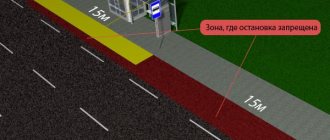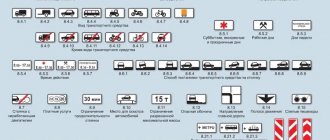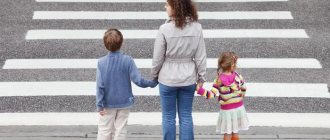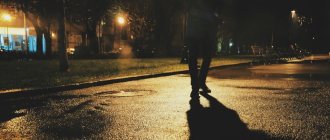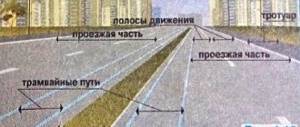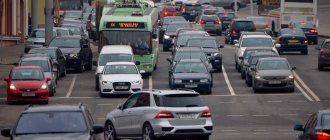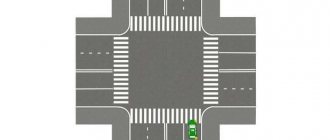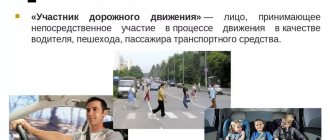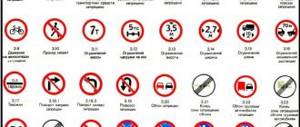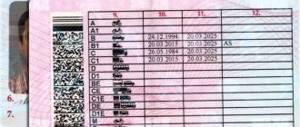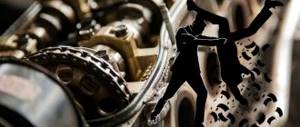Stop, car!
Traffic regulations clearly define the list of car faults with which you cannot drive. Clause 2.3.1:
“Driving is prohibited if there is a malfunction of the service brake system, steering, coupling device (as part of a road train), unlit (missing) headlights and tail lights in the dark or in conditions of insufficient visibility, the windshield wiper is inoperative on the driver’s side during rain or snowfall”
.
Other malfunctions - a smoking engine, a damaged windshield, a “cutting” exhaust - are not a reason to prohibit you from further driving.
“If other faults arise along the way, for which the appendix to the Basic Provisions prohibits the operation of vehicles, the driver must eliminate them, and if this is impossible, then he can proceed to the place of parking or repair, observing the necessary precautions.”
Tinting not in accordance with GOST, different and “bald” wheels, colored flashlights, etc. are a clear violation of the same paragraph 2.3.1:
“The driver is obliged to check before leaving and ensure the good technical condition of the vehicle on the way in accordance with the Basic Provisions for the admission of vehicles to operation and the responsibilities of officials to ensure road safety.”
It is clear that the tint itself could not stick to your car. You and she drove onto the road in violation of the Rules.
Drive on red
One of the most common violations is driving through a prohibiting (red) traffic light. However, the traffic rules have clause 13.7, which stipulates the following cases:
“A driver who enters an intersection when the traffic light signal permits must drive in the intended direction regardless of the traffic light signal at the exit from the intersection.”
.
However, this is only permissible if there is no stop line in front of the traffic light.
Prohibiting signals at a traffic light do not mean that you cannot exit the intersection under them. It is possible and necessary!
Prohibiting signals at a traffic light do not mean that you cannot exit the intersection under them. It is possible and necessary!
Location of vehicles on the roadway
When turning left or making a U-turn, take the extreme left position on your side of the road.
That is, the road
divided by gender.
Yours, accordingly, is on the right side of the roadway. When turning right, take the extreme right position and turn only in a small radius, which means from the extreme right to the extreme right position
on the road.
The same goes for turning left. Look in advance at the signs indicating the direction of movement in the lanes. Read more here
Turn according to the arrow
A common controversial situation on the road is turning at the arrow that allows a turn. If a traffic cop claims that this is a violation, it is a lie. Clause 6.3: “Traffic light signals, made in the form of arrows in red, yellow and green, have the same meaning as round signals of the corresponding color, but their effect applies only to the direction(s) indicated by the arrows. In this case, the arrow allowing a left turn also allows a U-turn, unless this is prohibited by the corresponding road sign.” In this case, you must remember clause 8.11: “Turning is prohibited:
- at pedestrian crossings;
- in tunnels;
- on bridges, overpasses, overpasses and under them;
- at railway crossings;
- in places where visibility of the road in at least one direction is less than 100 m;
- in places where route vehicles stop."
Turning under the left turn arrow is permitted. All exceptions are listed in the traffic rules.
Turning under the left turn arrow is permitted. All exceptions are listed in the traffic rules.
Start of movement, maneuvering
The beginning of movement is the beginning of beginnings.
This topic in the exam papers covers more than three questions in one paper.
The first rule - before the first trip on the road, a novice driver must confidently master all the controls of the car -
to press the brake or gas pedal in time.
Know that it is necessary to turn on the direction indicators in advance when performing a maneuver, and turn them off immediately after its completion.
When entering the road from adjacent areas, give way to everyone who crosses your path.
Turning is carried out only from the leftmost lane; exceptions may only be for long road trains or narrow roadways.
Read more here
.
Accident
One of the most favorite “horror stories” for illiterate drivers is changing the position of vehicles on the roadway after an accident or leaving the scene of an accident. However, the traffic rules contain clause 6.1, which not only does not prohibit, but, on the contrary, prescribes such actions if only cars are damaged and they interfere with traffic:
“If, as a result of a traffic accident, damage is caused only to property, the driver involved in it is obliged to clear the roadway if the movement of other vehicles is obstructed, having previously recorded by any possible means, including by means of photography or video recording, the position of the vehicles along relation to each other and road infrastructure, traces and objects related to the incident, and damage to vehicles.”
The State Duma has tightened the punishment for leaving the scene of an accident - if the accident led to harm to health or death. If only the iron is dented, you can register without the traffic police.
The State Duma has tightened the punishment for leaving the scene of an accident - if the accident led to harm to health or death. If only the iron is dented, you can register without the traffic police.
Travel speed
Next, you need to be able to maintain the speed of your car corresponding to the speed of traffic on the road, and when moving slowly, not interfere with other road users, for which you can also get a fine. To join the flow you must be ready for it.
If you are afraid and cannot move at the set speed, or for any other reason, simply turn on the hazard lights, look in the rearview mirror and gradually begin to move to the right, and stop on the side of the road, or as far to the right as possible to the edge of the roadway, put up a warning triangle at a distance of at least 15 meters behind your car. If you are on a turn, the distance from your car to the sign must be at least 30 meters.
Permissible speed according to the Rules:
- In residential and courtyard areas no more than 20 km/h
- On roads in populated areas no more than 60 km/h
- Outside the populated area no more than 90 km/h ( there are restrictions for various vehicles)
- On the Motorway no more than 110 km/h and no less than 40 km/h (there are restrictions for various vehicles)
More details here
The driver is prohibited
Probably the most difficult traffic rule to perceive and remember, which everyone should still learn, but not for traffic cops, but for yourself - 2.7. This is a list of what is prohibited for the driver. The list is impressive:
“drive a vehicle while intoxicated (alcohol, drugs or other), under the influence of medications that impair reaction and attention, in a painful or tired state that jeopardizes traffic safety; transfer control of a vehicle to persons who are intoxicated, under the influence of medications, in a sick or tired state, as well as to persons who do not have a driver’s license to drive a vehicle of the appropriate category or subcategory, except for cases of driving training in accordance with section 21 Rules; cross organized (including foot) columns and take a place in them; consume alcoholic beverages, narcotic, psychotropic or other intoxicating substances after a traffic accident in which he is involved, or after the vehicle was stopped at the request of a police officer, before an examination to determine the state of intoxication or before a decision on release is made from carrying out such an examination;
The traffic rules state that the driver is prohibited from driving a vehicle while ill or under the influence of medications that impair reaction and attention.
The traffic rules state that the driver is prohibited from driving a vehicle while ill or under the influence of medications that impair reaction and attention.
drive a vehicle in violation of the work and rest regime established by the authorized federal executive body, and when carrying out international road transport - by international treaties of the Russian Federation; use while driving a telephone that is not equipped with a technical device that allows hands-free conversations. dangerous driving, expressed in the repeated performance of one or several consecutive actions, consisting of failure to comply with the requirement to give way to a vehicle using the right of way when changing lanes, changing lanes in heavy traffic when all lanes are occupied, except when turning left or right , turning, stopping or driving around an obstacle, failure to maintain a safe distance to the vehicle moving in front, failure to maintain a lateral interval, sudden braking, if such braking is not required to prevent a traffic accident, obstruction of overtaking, if these actions resulted in the driver creating a situation in the process of traffic , in which its movement and (or) the movement of other road users in the same direction and at the same speed creates a threat of death or injury to people, damage to vehicles, structures, cargo or other material damage.”
Obviously, this point is simply not familiar to many drivers or has been erased from memory. Worth a refresh.
10 traffic rules that a driver should know by heart
Driving schoolhome traffic rules online
We have launched free distance learning on Youtube. Subscribe to our channel and watch video lectures.
Responsibility #1.
Rules.
Section 2. Clause 2.3.1. The driver of the vehicle is obliged to check before leaving and ensure that the vehicle is in good technical condition during the trip.
Here’s a real situation: a tractor’s wheel fell off while it was moving—this sometimes happens (and not only with tractors). So, in this case, the driver cannot “turn the tables” on the mechanic who screwed up this wheel poorly yesterday.
The driver is responsible for everything that happens on the road with his vehicle!
The driver is obliged not only to know all the malfunctions with which the operation of vehicles is prohibited,
but also be able to detect them in time.
What does “exploitation prohibited” mean? This means that the fault must be detected and corrected. The tractor driver, if he weren’t a complete idiot, should have realized that something had been wrong with the machine for a long time (shaking, twitching, loud knocks could be heard from behind). Well, it was worth not being lazy, going out and seeing that it was the wheel rumbling. That the wheel bolts were just tightened, but they forgot to tighten them.
The rules contain a complete list of faults with which the operation of vehicles is prohibited, and we will get acquainted with it in the future - in topic 25. For now, we will only note that the prohibition of operation does not mean that further movement is prohibited at all. Well, imagine that the speedometer fails while driving. Operation with such a malfunction is prohibited. It is impossible to eliminate such a malfunction. What to do? Abandon the car? Yes, somehow this is wrong.
In this case, the rules allow you to get to the place of repair or parking in compliance with all precautions.
(that is, very slowly, in the far right lane, with your hazard lights on).
Responsibility #2.
In addition to the list of faults with which the operation of vehicles is prohibited, the Rules also identified five faults with which further movement is strictly prohibited.
Rules.
Section 2. Clause 2.3.1. Driving is prohibited if there is a malfunction of:
– the service brake system,
– steering,
– coupling device (as part of a road train),
– unlit (absent) headlights and tail lights in the dark or in conditions of poor visibility,
– the driver’s side windshield wiper does not operate during rain or snowfall.
If the service brake system is faulty or the steering is faulty!
Experienced drivers joke gloomily: “Brakes and prison begin with the same letter.”
True, nothing has been invented yet about the steering, but you must agree - what kind of further movement can you think about if there are no brakes or the car does not obey the steering wheel.
If the coupling device is faulty!
We are talking about a towing device designed for towing trailers.
In relation to a passenger car, this is a well-known device called a towbar - a coupling ball with a diameter of 50 mm, onto which a response head mounted on the trailer drawbar is attached.
The trailer, if it comes off while moving, then acts like a bowling ball, directed by a skillful hand into the thick of the pins.
Therefore, at the slightest suspicion of a malfunction of the coupling device (towbar), it is necessary to stop further movement with the trailer.
If the headlights and tail lights do not light or are missing!
If this disaster happened during the day in clear weather, you can drive to the nearest car service center taking all precautions.
If this happens at night or in poor visibility conditions, you must move the car off the road and wait until dawn and clear weather.
If the driver's side windshield wiper does not work!
During rain or snowfall, you cannot see anything if the windshield wiper is not working. Therefore, the Rules in this case naturally prohibit further movement.
As soon as the rain (or snowfall) stops, you can continue driving (but only to your home or to the nearest car service center, and taking all precautions).
Responsibility #3.
Rules.
Section 2. Clause 2.1.1. The driver of a motor vehicle is obliged to carry with him and, at the request of police officers, hand over to them for verification the entire set of necessary documents.
The set of necessary documents is this:
– a driver’s license or temporary permit to drive a vehicle of the appropriate category or subcategory;
– registration documents for this vehicle (except for mopeds), and if there is a trailer – also for the trailer (except for trailers for mopeds);
– insurance policy of compulsory civil liability insurance of the vehicle owner;
– a document confirming the fact of disability, in the case of driving a vehicle on which the identification sign “Disabled” is installed.
I would like to draw your attention to this important point.
The rules oblige drivers to carry with them and upon request of police officers
provide them with the entire list of required documents for verification.
Therefore, we drivers deal only with the police!
No military or civilian persons (for example, vigilantes) have the right to demand our documents.
Only police officers!
Responsibility #4.
Rules.
Section 2. Clause 2.3.2. The driver of a motor vehicle is required , at the request of officials authorized to carry out federal state supervision in the field of road safety, to undergo an alcohol intoxication test.
If, at the request of a traffic police inspector, you cannot quickly and clearly pronounce the word “lilac” three times in a row, he will have sufficient reason to believe that the driver is intoxicated.
And it's not a joke.
In the list of “reasons sufficient to believe...” there is also one – “speech impairment” (see Decree of the Government of the Russian Federation of June 26, 2008 No. 475).
In such cases (when there are grounds sufficient to believe...) the rules oblige drivers to undergo an intoxication test.
However, not any police officers can request to undergo an examination, but only officials authorized to carry out federal state supervision in the field of road safety
(Rules, section 2, clause 2.3.2).
I can’t tell you how to distinguish “that official” from the “wrong official” (the Rules don’t say anything about this), I just want you to know about its existence and correctly answer the corresponding question in the traffic police exam . And in life, it won’t hurt you to know that any police officer has the right to demand documents (from both a pedestrian and a driver) for verification, but not every police officer has the authority to oblige you to undergo a medical examination to determine the state of intoxication.
Although in life this will not have much meaning for you and me, because any traffic police inspector certainly has the right to demand a medical examination for intoxication. Any traffic police inspector is undoubtedly “an official who
is authorized to exercise federal state supervision in the field of road safety.”
| At the request of which persons it is necessary to submit for verification a driver's license for the right to drive a vehicle of the corresponding category or subcategory, an insurance policy of compulsory civil liability insurance, and registration documents for a vehicle? 1. Police officer. 2. Employee of the Military Automobile Inspectorate. 3. Any traffic controller. 4. All listed persons. |
| At the request of which persons are drivers required to undergo an alcohol intoxication test and a medical intoxication test? 1. All traffic controllers. 2. Officials authorized to carry out federal state supervision in the field of road safety. 3. Any police officers. |
Responsibility #5.
The driver of a vehicle must
know what vehicles he is allowed to drive.
There is nothing in the traffic rules themselves about this. The classification of vehicles is defined in Article 25 of the Federal Law “On Road Safety”. No one obliges you to know all the categories, but to know what categories A, B, M
and subcategories
A1, B1
are now your responsibility.
So, what are categories A, B, M and what are subcategories A1 and B1.
Driving license category A
allows you to control any motorcycles (and in general, any motor vehicles).
Subcategory A1
allows you to drive motorcycles with a small engine capacity (no more than 125 cubic centimeters) and a small maximum power (no more than 11 kilowatts).
Driving license category B
allows you to drive cars, as well as small trucks and minibuses.
At the same time, cars included in category B
, must meet two mandatory conditions:
– The number of seats for passengers is no more than eight.
– Permitted maximum weight – no more than 3.5 tons.
Subcategory B1
These are tricycles and quadricycles.
From the text of the Federal Law it follows that tricycles and quadricycles can have a motorcycle-type seat and motorcycle-type handlebars.
And they can be with a car seating position (round steering wheel and pedals on the floor).
Category M
these are mopeds and scooters (the same mopeds).
And here are a few more excerpts from the Federal Law “On Road Safety”.
1.
The Russian national driver's license, which confirms the right to drive vehicles of category “A”, also confirms the right to drive vehicles of subcategory “A1” and subcategory “B1” with a motorcycle seat and motorcycle-type handlebars.
That is, as was said, with a category “ A”
you can drive any motor vehicle.
2.
A Russian national driver's license, which confirms the right to drive vehicles of category “B”, also confirms the right to drive vehicles of subcategory “B1” (except for vehicles with a motorcycle seat or motorcycle-type handlebars).
That is, with a category
“B” , you can also drive tricycles and quadricycles (but only those with a round steering wheel and pedals on the floor, like a car).
3.
A Russian national driver's license, confirming the right to drive vehicles of any category or subcategory, confirms the right to drive vehicles of category “M”.
That is, with a license of any category or subcategory, you can also ride a moped.
What you need to know about driving with a trailer.
The rules allow owners of category B vehicles to drive with a trailer, but only if it is a small trailer. A trailer is also a vehicle (only without an engine), and it also has its own permissible maximum weight.
If the permitted maximum weight of the trailer does not exceed 750 kg, you can safely drive with it, having a category “B” license.
If the permitted maximum weight of the trailer exceeds 750 kg, then category “B” license is not enough; category “E” must also be added to category “B”.
You should also be aware that the Law does not prohibit you from giving control of your vehicle to another person, such as one of your friends. In this case, it is necessary and sufficient that your friend has rights of the appropriate category, and he must be included in your OSAGO policy. Or if you have taken out an MTPL policy without restrictions.
Responsibility #6.
Rules.
Section 2. Clause 2.1.2. The driver of a power-driven vehicle is obliged, when driving a vehicle equipped with seat belts, to be fastened and not to carry passengers who are not wearing seat belts.
When driving a motorcycle, wear a fastened motorcycle helmet and do not carry passengers without a fastened motorcycle helmet. The rules do not make any exceptions for anyone - both the driver and all passengers must wear seat belts while driving.
And everyone who rides a motorcycle must wear a fastened motorcycle helmet.
These requirements apply equally to ordinary citizens (both adults and children) and to drivers and passengers of emergency services vehicles (police, ambulance, fire department, etc.).
The rules took into account that not all cars are equipped with seat belts - for example, they may not be on trucks, as well as on older cars. That is why the Rules made such a clarification - everyone must be fastened if the vehicle is equipped with seat belts.
This clarification, by the way, needs to be understood correctly. If you remove seat belts from a modern passenger car, this does not mean that your car has now become “unequipped” and you can drive without wearing one. Does your car have seat belts? Provided. This means there must be, and if they are not, it is prohibited to operate such a car.
And here’s what else is significant and important! Responsibility for fulfilling these requirements rests equally with passengers and drivers! On the one hand, passengers are required to be fastened while driving, and on the other hand, the driver is prohibited from transporting passengers who are not wearing seat belts. It’s the same with motorcycles: the passenger’s responsibility is to wear a fastened motorcycle helmet, and the driver’s responsibility is not to carry passengers without a fastened motorcycle helmet.
Responsibility #7.
Rules.
Section 2. Clause 2.3.3. The driver of a power-driven vehicle is obliged, in cases provided for by law, to provide the vehicle:
a). Police officers.
b). Employees of federal state security agencies.
V). Employees of the federal security service.
Drivers, as a rule, love their vehicles, treat them with reverence, and the prospect of giving our car or motorcycle to anyone, frankly speaking, does not make us happy.
Therefore, the rights of all the above-mentioned government representatives are officially legalized.
Both the Law of the Russian Federation “On the Police”, and the Federal Law “On State Security”, and the Law “On the Federal Security Service” contain approximately the same list of conditions under which drivers are required to provide their vehicles, namely:
– To travel to the site of a natural disaster.
- To travel to the scene of the incident.
– To deliver citizens in need of urgent medical care to medical institutions.
– In cases of prosecution of persons who have committed crimes.
– For transportation of vehicles damaged in accidents.
And all this with the right to remove drivers from driving vehicles and with subsequent compensation for material damage (in the manner established by civil law).
Responsibility #8.
Drivers (like all people) have a responsibility
to be compassionate.
In cases where it is necessary to urgently transport sick or injured people to a medical facility, ambulances specially designed for this purpose are usually used.
However, if doctors do not have such a car at their disposal, they have the right to turn to any driver who happens to be nearby. And no one has the right to refuse them.
We are obliged to do this, first of all, because we are PEOPLE!
But for those who have forgotten this, the Rules, just in case, legitimized this norm:
Rules.
Section 2. Clause 2.3.3. paragraph 2. The driver of a motor vehicle is obliged to provide the vehicle to medical and pharmaceutical workers for transporting citizens to the nearest medical institution in cases that threaten their lives
.
As you can see, the right to use your car is granted to all medical and pharmaceutical workers, but not always, but only in emergency cases when the life of a patient or injured person is threatened.
Responsibility #9.
The driver of a vehicle must
know how to behave if he is involved in a traffic accident.
The algorithm for the actions of a driver involved in an accident is described in detail in the Rules, taking into account all possible options, and below I will give it in full.
But I warn you!
Now you have to wade through the jungle of normative vocabulary of the Rules!
Not everyone manages to complete this journey. But at least get an impression.
Rules. Section 2. Clause 2.5.
In the event of a traffic accident, the driver involved in it is obliged to immediately stop (not move) the vehicle, turn on the hazard warning lights and display an emergency stop sign in accordance with the requirements of paragraph 7.2 of the Rules, and not move objects related to the incident.
Rules. Section 2. Clause 2.6.
If people are killed or injured as a result of a traffic accident, the driver involved in it is obliged to:
– take measures to provide first aid to the victims, call emergency medical services and the police;
– in emergency cases, send the victims along the way, and if this is not possible, deliver them in your vehicle to the nearest medical facility, provide your last name, registration plate of the vehicle (with presentation of an identification document or driver’s license and registration document for the vehicle) and return to the scene of the incident;
- clear the roadway if the movement of other vehicles is impossible, having previously recorded, including by means of photography or video recording, the position of the vehicles in relation to each other and road infrastructure, traces and objects related to the incident, and take all possible measures to their preservation and organization of a detour to the scene of the incident;
– write down the names and addresses of eyewitnesses and wait for the police to arrive.
Rules. Section 2. Clause 2.6.1 . If, as a result of a traffic accident, damage is caused only to property, the driver involved in it is obliged to clear the roadway if the movement of other vehicles is obstructed, having previously recorded by any possible means, including by means of photography or video recording, the position of the vehicles in relation to to each other and road infrastructure, traces and objects related to the incident, and damage to vehicles.
Drivers involved in such a traffic accident are not required to report the incident to the police and can leave the scene of the traffic accident if, in accordance with the legislation on compulsory civil liability insurance of vehicle owners, paperwork about the traffic accident can be carried out without participation authorized police officers.
If, in accordance with the legislation on compulsory civil liability insurance of vehicle owners, documents regarding a traffic accident cannot be completed without the participation of authorized police officers, the driver involved in it is obliged to write down the names and addresses of eyewitnesses and report the incident to the police for receiving instructions from a police officer about the location of the registration of a traffic accident.
The stress from such reading is no less than from a real accident.
Well, calm down, calm down. What happened, happened.
Yes, it’s terrible, yes, it’s a nightmare, but you need to pull yourself together and start acting.
In the event of an accident, the first thing the driver must do is stop, turn on the hazard warning lights and put up a warning triangle.
Here, it seems, everything is clear, drivers act exactly like this - they stop, turn on the emergency lights and put up an emergency stop sign. Everyone knows this.
What's next? What to do next?
And then several scenarios are possible.
If people are killed or injured as a result of a traffic accident.
Here you don’t need to read any Rules, first of all, pay attention to the victims.
At the same time, you must call an ambulance and the police.
In emergency cases (decide for yourself), the victims must be sent to the nearest hospital without waiting for an ambulance.
And here attention is important!
If the victim is carried by a participant in the accident, he must return immediately.
In this case, it is mandatory to present documents at the hospital and record the fact of your participation in the transportation of the victim (provide your last name and registration plate of your vehicle).
Otherwise, the driver may be charged with illegally leaving the scene of an accident. And for this, by the way, there is a penalty - deprivation of rights for a period of 1 - 1.5 years.
So, the emergency lights are on, the warning triangle is up, the victims have been taken away by ambulance, what to do next?
If the traffic cops arrived, then they will then “command the parade.”
All you have to do is follow all their instructions.
But today the police do not arrive quickly. There are few traffic cops; you can’t cope with all the accidents. Legislators found a way out of the situation (what the authorities cannot do, let the citizens do it themselves) and assigned several more responsibilities to drivers.
If the movement of other vehicles as a result of an accident has become impossible.
In this case, drivers are obliged
themselves, without waiting for traffic cops, to record by means of photography or video recording the position of vehicles in relation to each other and road infrastructure objects...
... as well as traces and objects related to the incident, and take all possible measures to preserve them.
Now let's clear the roadway.
This is the next one
(I don’t remember what)
the responsibility of drivers.
I emphasize!
Drivers are required to clear the roadway (after taking a bunch of photos) if they make traffic impossible.
But that's not all.
After the drivers cleared the roadway, it was their turn to perform the next duty.
–
write down the names and addresses of eyewitnesses.
Now all that remains is to wait for the police to arrive. And this is also a duty!
So, we have fully analyzed the situation specified in paragraph 2.6 of the Rules, when there are victims as a result of an accident.
The next paragraph (clause 2.6.1) is entirely devoted to an accident in which there are no casualties. How should drivers behave in this case? Let's figure it out.
If, as a result of an accident,
damage was caused only to property.
And here, too, legislators tried to free up traffic cops as much as possible, and transferred everything that was possible to the drivers.
Among other things, drivers must decide whether they will file an accident on their own or with the participation of traffic cops.
Current legislation allows, under certain conditions, to register an accident without the participation of authorized police officers, but, thank God, it does not oblige you to do this. Drivers have the right to decide for themselves what they should do.
But how to make the right decision? There are no direct instructions in paragraph 2.6.1 of the traffic rules. There is only a link to the Law on Compulsory Motor Liability Insurance.
That is, you, dear fellow drivers, in addition to traffic rules, also need to know the law on compulsory motor liability insurance. Type the words “ Article 11.1. Preparation of documents regarding a traffic accident without the participation of authorized police officers” and read. And when you read it (if, of course, you master it), you will understand that everything that is written there can be summed up in one phrase: people, never, under any circumstances, agree to register an accident without the participation of authorized police officers!
So, in all cases, we file road accidents only with the participation of traffic cops.
Now my task is to rewrite paragraph 2.6.1 in human language and at the same time show you the required sequence of actions:
1. Turn on the emergency lights and set up a warning triangle.
2. Take photographs of the position of vehicles in relation to each other and road infrastructure, traces and objects related to the incident, damage to vehicles.
3. Clear the roadway if the movement of other vehicles is obstructed.
4. Write down the names and addresses of eyewitnesses.
5. Next, call the police, tell them what happened, and get instructions from the police officer about the place where the traffic accident was registered.
Responsibility #10.
The driver of a vehicle is obliged, in the event of a forced stop of a vehicle or a traffic accident outside populated areas in the dark or in conditions of limited visibility while on the roadway or side of the road, to be dressed in a jacket, vest or cape vest with stripes of reflective material.
From the text of the Rules it follows that this requirement of the Rules must be observed not everywhere, but only on roads outside populated areas (no matter on the roadway or on the side of the road), and not always, but only at night (regardless of the road illumination), as well as during the day ( if this is a section of road with limited visibility).
And as you understand, complying with this requirement of the Rules is in your own interests!
In the second section of the Rules there is still a whole heap of “general duties” left, which, in my opinion, are understandable and do not require comment.
Rules.
Section 2. Clause 2.7. The driver is prohibited from:
– driving a vehicle while intoxicated (alcohol, drugs or other), under the influence of medications that impair reaction and attention, in a painful or tired state that jeopardizes traffic safety;
– transfer control of a vehicle to persons who are intoxicated, under the influence of medications, in a sick or tired state, as well as to persons who do not have a driver’s license for the right to drive a vehicle of this category or, in the event of its seizure in the prescribed manner, a temporary one permits except for driving lessons in accordance with section 21 of the Rules;
– cross organized (including foot) columns and take a place in them;
– consume alcoholic beverages, narcotic, psychotropic or other intoxicating substances after a traffic accident in which he is involved, or after the vehicle has been stopped at the request of a police officer, before an examination to establish the state of intoxication or before a decision is made exemption from such examination;
– drive a vehicle in violation of the work and rest regime established by the authorized federal executive body, and when carrying out international road transport - by international treaties of the Russian Federation;
– use a telephone while driving that is not equipped with a technical device that allows hands-free negotiations;
– dangerous driving, expressed in repeated performance of one or several subsequent actions, consisting of failure to comply with the requirement to give way to a vehicle using the right of way when changing lanes, changing lanes in heavy traffic when all lanes are occupied, except when turning left or to the right, turning, stopping or going around an obstacle, failure to maintain a safe distance to the vehicle moving in front, failure to maintain a lateral interval, sudden braking, if such braking is not required to prevent a traffic accident, obstruction of overtaking, if these actions entailed the creation of a driver in the process of traffic a situation in which its movement and (or) the movement of other road users in the same direction and at the same speed creates a threat of death or injury to people, damage to vehicles, structures, cargo or other material damage.
